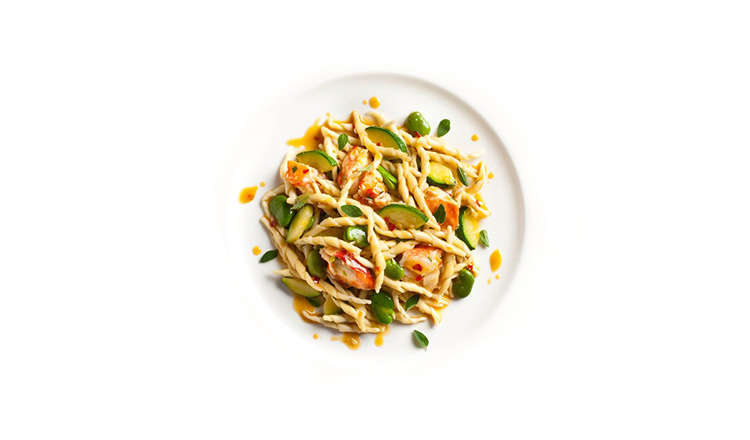Makes 4 to 6 servings
Featuring the best ingredients of late spring and early summer, this decadent lobster pasta is perfect alongside a crisp glass of white wine for dinner al fresco.
Ingredients
- 1/4 cup extra-virgin olive oil
- 1 leek, well washed, cut in half, and thinly sliced (white part only)
- 2 shallots, minced
- 2 garlic cloves, chopped
- 1 1/2 teaspoon minced thyme
- 1/3 cup cognac
- 1/2 cup dry white wine
- 3 cooked lobsters (about 1 1/2 lb each), meat diced, and coral and tomalley reserved (see note)
- Kosher salt, as needed
- Freshly ground black pepper, as needed
- Red pepper flakes, as needed
- 1/2 cup chopped flat-leaf parsley
- 10 oz zucchini, quartered and sliced
- 2 lb fresh unshelled fava beans
- 1 lb dried trofiette, spaghetti, linguine, or bucatini
- Marjoram leaves for garnish (optional)
Directions
- Heat the oil in a large sauté pan large over medium heat. Add the leek and shallots and cook, until they are tender and translucent, about 3 minutes. Add the garlic and thyme, and cook, stirring frequently, until the garlic is aromatic, about 3 minutes. Add the cognac and when the cognac is hot, light it with a match and let the alcohol burn away. Add the wine, the lobster, the reserved tomalley and coral, and any juices from the lobster. Season with salt, black pepper, red pepper flakes or jalapeño, and half of the parsley.
- Add the zucchini and fava beans, stir well, and cover the pan. Cook, stirring as needed, until the zucchini and lobster are cooked through and tender, 5 to 6 minutes. Season with a pinch of salt and pepper. Set aside.
- Bring a large pot of salted water to a boil over high heat. Add the trofiette and stir to submerge and separate the pasta. Cook, uncovered, until the pasta is just tender (al dente), 8 to 10 minutes (check the cooking time for your pasta).
- Drain the trofiette in a colander. Shake well to remove any water clinging to the pasta. Pour the drained trofiette into the pan with the lobster and zucchini and toss together over medium heat. Add the rest of the parsley.
- Serve the trofiette at once in a heated serving bowl or in pasta plates topped with the marjoram, if using.
Chef’s Note: To prepare the lobster for this dish, bring a large pot of water to a rolling boil. Add the lobsters, one at a time, head first, to the pot. Return the water to boil. Cook, uncovered, until the shells are a brilliant red, 2 to 3 minutes. Transfer the lobster to a cutting board and let it cool enough so that you can handle it. Use kitchen shears to cut off the claws and pull out the meat, including knuckle meat. Use a nutcracker to crack the shells open, if necessary. Cut the tails away from the body and cut through the underside of the shell; pull out the meat and cut it into dice. Reserve the claw and tail meat. Cut each lobster body in half lengthwise, and pull out the any coral (bright orange part) or tomalley (green part) and transfer with any juices into a separate bowl.


